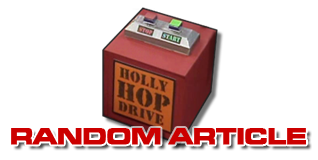 |
Interior Designer Where do you get a 23rd century starship cockpit when you need one? Mel Bibby knows - he's the man responsible for the look of Red Dwarf from Series III onwards. Just don't mention the studio audience... |

Andrew Ellard
Mr Flibble whispered his first question to Andrew who dutifully passed it on: What was the ORIGINAL BRIEF you were given when you started on the third season of Red Dwarf? Were you asked to make a lot of changes?
That's probably why I was brought in at that time, because Paul Montague's brief was a mundane, grey setting. Which was fine, I think it worked rather well. But when I was brought on, Rob and Doug said that - to ring the changes - the crew wouldn't stay in their own quarters, which were sort of lowly quarters; with nobody else on board they would seek better quarters. Which is what we did.
It gave us a chance to upgrade the look of things. But we still kept, as far as we could, the grey - not mundane - look of things. A lot of the influence was Alien, I took a lot from that - nicked a lot from that! (Laughs) At that time we started experimenting a lot more with sound, as well; putting in background sounds, a woosh on the doors and stuff like that. So it was kind of upmarket from there.

How does it compare doing something set in the future to something contemporary? Because you can't just pick up a cockpit in Ikea...
It's a damn sight more interesting! But again everything develops. When we started off, Starbug, for instance, was just a one-off set, a side-set, for a one-off episode [Marooned]. If you look at the early ones it was basic plumbing fittings and all sorts. But then it developed. They eventually lose the ship and spend all their time on Starbug - and suddenly Starbug has got two or three floors! If you look at the model, the size of the cockpit, now the interior wouldn't fit in that area! But so what? This is television.
Season III was shot in Manchester, but after that the PRODUCTION MOVED - did that change the way you worked?
We left the studios in Manchester and came down to Shepperton, which was a hell of a difference from my point of view, because in Manchester the studio is running seven days a week, and we were shooting [on] two. So you had to put [the set] up and take it down, and store it [every week]. Which is a pain in the arse, obviously. But when, in Shepperton, we put the set and the seating in, it stayed - and was used for rehearsals and everything. The beauty from my point of view is that you can go around 'titivating' as the weeks go on.
Mr Flibble took out his notebook and made a note of the word 'titivating' for later, possibly comedic, use. Andrew asked Mel for what he saw as the DEFINITION of his job...
The only way to describe it is that I'm responsible for everything you see on-screen apart from costume and make up. My responsibilities are the set and the props, as well as the general running and layout of the studio. How it's operated - safety standards, the lot. From that point of view you get involved with the seating, because the seating is crucial to safety. It's entailed in the studio layout, making sure everybody can get out.
You mentioned the props, which people aren't aware you work on...
On my team there would be me, an art director (who is basically my assistant), then a crew of a prop master and three prop guys, and then there would be a prop buyer. I decide what we're going to put on the set - from a glass of water to an ashtray to books, all the junk that goes on there. Then the prop buyer comes along and he sources it first, then I go along with him and choose it.
All the sets are made off-site by a construction company. They were made by Scene Change, and they're over in the East End of London. It gets to the stage where we're so late at times that we fax them drawings on an A4 a page, they make them overnight and deliver them the following morning! (Laughs) It does get a little hectic...
The first two scripts tend to be very heavy, from a construction point of view, because you've got time to build them up. Doug knows this, so he tends to put the construction-heavy scripts up front. It does get to the point where you know you've got enough money to complete the series, if there isn't too much construction effort required. Doug understands that and he writes scripts that aren't heavy - we've all got budgets to (hopefully) come in on.

When Series VII happened, you finally got to do sets with FOUR WALLS...
Series VII was a lot harder, with the four-wallers. We had no audience so we weren't restricted to the times the audience gave us. [With an audience] we tried to get the whole recording in the can [in one evening] - although there was a lot of pre-recording going on. But with the audience there we've got from 7:30pm to 10pm, and that's it. But with no audience, and rehearse-record, you can start at 8am and go on until 8pm. Twelve hour days.
But I found it much more rewarding. With an audience you've got to have sets like theatre sets, if you like, so the audience can see into them, what's going on. Without an audience you've got four walls, and you can actually put a lot more detail in. Nothing against the audience personally, but from my point of view, they do get in the way! The argument for the audience is that it's good for the artists, it gives them some response.
Do you think it ups the show's production values?
From a lighting point of view, it can be lit from shot to shot. It gave Pete Morgan, the lighting director, more time to get in there and tweak the lights. Whereas in front of an audience, you can't run in and tweak the lights. So I thought the overall results were better, from everybody's point of view.
When all is said and done, they're bits of plastic and wood - they're not real space ships! When you are lighting for shot, you can shade off, bring the lights off the backing, it has a much more solid feel to it. Whereas with an audience, you're relying on a lot of soft light just to light 'overall.' You've got four or five cameras lined up in front of the set, you've got booms trying to get in, so it's all got to be floodlit so everybody sees what they're looking at.
Have you found it useful that nobody's ever drawn up full schematics detailing every room and floor for Red Dwarf or Starbug?
Yeah. Red Dwarf is the size of a city - you could go mad trying to think out what the interior of Red Dwarf looks like! I haven't actually worked on that many [sets] that were meant to be [on] Red Dwarf, when you think about it. They've mainly been on Starbug.
The early ones were Red Dwarf, obviously; but when they lost Red Dwarf it all became Starbug - and that's when it became more interesting to me. Because I thought Starbug was a lot 'neater' in so much as it was a shuttle craft that took miners down to the planetoid or whatever, so it was dingy and dirty, with mining equipment in. But when they started living on it, it got a little cleaner - they got medical quarters. How they got medical quarters or sleeping quarters I'll never know! (Laughs) But this is comedy.
Moving on to SERIES VIII, you actually built a second cell behind the main cell set - was that used less than you expected?
Yes, but then again it wasn't supposed to be used [in an] ongoing [way]. It was there to give it depth. If you've got a small cell and a solid wall, it just seems all very crowded and cramped. So by putting that mesh in, and a cell beyond that, it gave a little depth to the sets; you could light that back room as well. Then hopefully, if the scripts require it, you can have some nutter in there rattling the wire.
We never used them in [direct relationship], in the same scene. You've got Rimmer and Lister in the front cell, and Kryten and Kochanski in the back one. [But] they're never joined.

Mr Flibble asked about Cassandra's ship, the Silverberg, which had a colour-scheme not unlike the old bunk room set...
I think I'd run out of ideas at that point! (Laughs) One of those sets I just kept putting off and putting off, although it was one of the early scripts. I just kept putting it off. It was all to do with the ending where she predicts [Lister] will kill her and he refuses, then starts walking out and has an accident. The script just said, 'Something hits something, hits something, hits something.' I kept saying, 'What does what does what?' So I kept putting it to the back of the pile because I couldn't figure out what was happening! I think it suffered because when it was brought to the front of the pile, something had to be done quickly.

How do you work on the show's LOCATION SHOOTS?
Lighting is crucial, especially on location stuff. It's how you shoot it as well - if you took a wide shot, you'd know it was a power station. It's the feel of a place, rather than the accuracy of the period. They walk past boilers with great big valves - you won't see those on a space ship! (Laughs) It doesn't matter - it's the feel.
Mr Flibble said he is more keen on serious, period drama. Do you enjoy the non-SF opportunities in the script?
You think, 'Oh, fab.' Ace Rimmer's opening sequence [in Stoke me a Clipper...] where he goes off and shoots [people], blows up an aircraft - you read that and you think, 'This is a whole episode of James Bond in five minutes!' Which is what it was meant to be. So that fills you with trepidation from a budget point of view. But we did it in an economical way and it was good fun to do.
We shot the German camp at an RAF base in North London. While we were there, we had these old huts that we'd doctored up - with tape on the windows - and German armoured cars and flags flying. We had to stop for about half an hour while the queen flew out! As the plane took off, she must have looked down at this battle going on down below and thought, 'What the hell's going on here?'
What about the JFK sequences in Tikka to Ride?
I always maintain that the stuff that we shot - with the assassination itself and the limo going down the road - you'd be hard-pressed to tell from the real footage, or from feature film footage. We weren't allowed to use any kind of references because they were all tied up in copyright. That was a good thing to do.

How did you find flooding your set for Duct Soup?
Duct Soup was an interesting one, because we couldn't flood the set in the studio. So, overnight, we had to take the set out and put it in a car park, then have a scaffold rig put over it to black it out. Logistically that was nice... well, not nice, but interesting. That was the last scene [shot] in the series. It's when Ed and Doug - as they will openly admit - got their own back on the cast. (Laughs) We just kept pumping more and more water!
Unfortunately it backfired. When the cast got out of the tunnels - Craig and Chloë - they wanted to go back in! They loved it!

What are you working on at the minute?
Very little! (Laughs) End of story. I'm doing a couple of exhibition stands for a computer company, but television-wise I'm not doing a lot. I consider myself semi-retired, and that's the way it should be at my age. (Laughs)
What are the stands like?
They want that Red Dwarf look - the plastic pallet look - but sprayed high silver. Very clean. Much more Star Trek-y than Dwarf-y. They don't want the dirt...
Mr Flibble enjoyed talking to Mel Bibby, and now that it's over... Mr Flibble's very cross.














